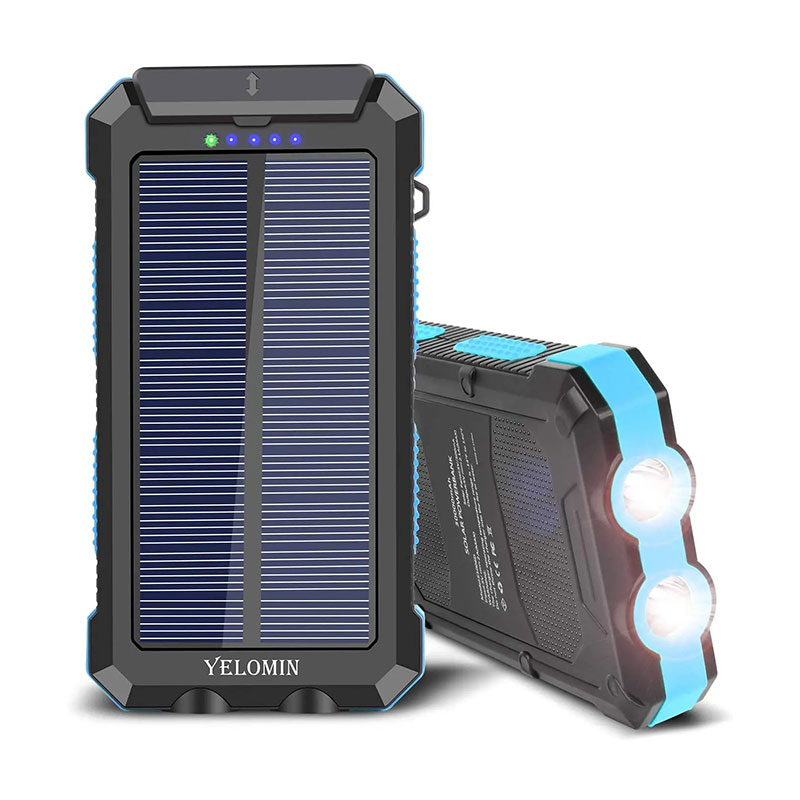Key Features of Solar Power Banks
2024-05-21
A solar power bank is a portable electronic device that stores electrical energy generated from sunlight and provides it for charging smartphones, tablets, cameras, and other USB-powered devices. These power banks integrate solar panels to harness solar energy, allowing users to recharge the battery bank outdoors, especially when access to conventional power sources is limited. Here's an overview of the features, functionality, and benefits of solar power banks:
Key Features of Solar Power Banks:
1. Solar Panels:
- Equipped with photovoltaic (PV) solar panels that convert sunlight into electrical energy.
- Typically located on the surface of the power bank, allowing for direct exposure to sunlight.
2. Battery Capacity:
- Available in various capacities, ranging from a few thousand milliampere-hours (mAh) to tens of thousands of mAh.
- Capacity determines the number of device charges the power bank can provide before needing recharging.
3. USB Ports:
- Include USB Type-A, Type-C, or micro USB output ports for charging devices.
- Allow simultaneous charging of multiple devices, depending on the power bank's capacity and output specifications.
4. Built-in Battery:
- Utilize lithium-ion or lithium-polymer batteries for energy storage.
- Provide reliable and stable power output to connected devices.
5. Charging Indicators:
- LED indicators display the charging status and remaining battery capacity of the power bank.
- Ensure users can monitor the power bank's performance and know when it requires recharging.
6. Durability and Weather Resistance:
- Designed to withstand outdoor conditions, including water splashes, dust, and shock.
- Encased in rugged and durable materials to protect the internal components.
7. Portability:
- Compact and lightweight design for easy carrying during outdoor activities, travel, and emergencies.
- Fits in backpacks, pockets, or glove compartments for convenient access.
Functionality of Solar Power Banks:
1. Solar Charging:
- Harness solar energy to recharge the power bank's battery during daylight hours.
- Ideal for outdoor activities such as camping, hiking, backpacking, and beach trips where access to conventional power sources is limited.
2. Battery Charging:
- Charge the power bank's battery via conventional methods, such as USB charging from a wall outlet or a computer.
- Ensure the power bank is fully charged before outdoor adventures to maximize solar charging efficiency.
3. Device Charging:
- Connect smartphones, tablets, cameras, GPS devices, and other USB-powered gadgets to the power bank for charging on-the-go.
- Provide emergency power backup during power outages or situations where access to electrical outlets is unavailable.
4. Dual Charging Modes:
- Support simultaneous charging via solar panels and USB input ports, allowing users to charge the power bank using solar energy while also charging devices from the power bank's battery.
Benefits of Solar Power Banks:
1. Off-Grid Charging:
- Enable charging of devices in remote locations, off-grid areas, or during outdoor adventures where access to electricity is limited or unavailable.
2. Environmentally Friendly:
- Utilize renewable solar energy as a clean and sustainable power source, reducing reliance on non-renewable fossil fuels.
3. Emergency Preparedness:
- Serve as essential backup power sources during emergencies, natural disasters, or blackouts, ensuring communication and device functionality.
4. Convenience and Versatility:
- Provide convenient access to power for charging devices outdoors, during travel, or while engaging in recreational activities.
- Versatile enough for use in various environments, including camping, backpacking, boating, and RVing.
5. Cost Savings:
- Reduce the need for disposable batteries or reliance on costly portable generators, offering long-term cost savings and energy independence.
Considerations When Choosing a Solar Power Bank:
1. Solar Panel Efficiency:
- Select power banks with high-efficiency solar panels capable of generating sufficient energy for charging the internal battery.
- Consider the size and orientation of the solar panels for optimal sunlight exposure.
2. Battery Capacity:
- Choose a power bank with a battery capacity suitable for your device charging needs and duration of outdoor activities.
- Higher capacity power banks provide more charges but may be bulkier and heavier.
3. Durability and Weatherproofing:
- Prioritize rugged and weather-resistant designs that can withstand outdoor conditions, including water, dust, and impact.
- Look for power banks with IPX-rated water resistance for added protection.
4. Output Compatibility:
- Ensure compatibility with your devices' charging requirements, including voltage, amperage, and connector types (e.g., USB Type-A, Type-C, micro USB).
5. Portability and Weight:
- Consider the size, weight, and portability of the power bank, especially if you'll be carrying it during outdoor activities or travel.
- Opt for lightweight and compact designs for easier transport and storage.
6. Charging Speed and Efficiency:
- Evaluate the power bank's charging speed and efficiency, both from solar panels and conventional charging methods, to ensure reliable device charging.
Conclusion:
Solar power banks offer a convenient and sustainable solution for charging USB-powered devices during outdoor adventures, travel, emergencies, and off-grid situations. With their solar panels, built-in batteries, and multiple USB output ports, these power banks provide reliable power backup and device charging capabilities in remote locations where access to electrical outlets is limited. By selecting a solar power bank with the right combination of features, durability, and capacity, users can stay connected, powered up, and prepared for any outdoor or emergency situation while minimizing their environmental impact.



